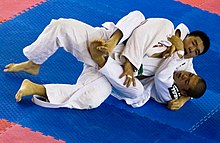Spinal Lock (Martial Arts)
A Spinal Lock / Spine Lock (in German: Spine Lever) is a submission in martial arts in which the spine is twisted so that the opponent has to give up.
Typically, this is done by twisting the head or torso into an abnormal position. Typically, spine locks can put strain on the muscles of the spine or cause a minor sprain , while a forcefully and / or suddenly applied spine lock can cause severe damage to ligaments, discs or vertebrae and potentially cause serious injury, stroke, or death . Spine locks, i.e. spine cranks and neck cranks, are prohibited in Brazilian Jiu-Jitsu competitions, amateur mixed martial arts , various forms of No- GI -Jiu-Jitsu and judo . They are allowed in professional MMA and some Brazilian Jiu-Jitsu competitions.
They are trained especially in 10th Planet schools .
Spine locks can be divided into two categories based on their primary area of action on the spine: attached to the neck, called "neck cranks" in German as "cranks" and in the lower area of the spine as "spine cranks" (in German about "spine cranks") ) designated.
Neck cranks
A neck crank (sometimes also referred to as "neck lock") is a spine lock that is applied to the cervical spine and causes hyperextension , hyperflexion , lateral hyperflexion, hyperrotation or extension -distraction. This is done either by bending, twisting, or stretching. A neck crank is typically used by pulling or rotating the head beyond its normal range of rotation. Neck cranks are usually excluded from sports competitions, with notable exceptions in martial arts such as submission wrestling and mixed martial arts, where they are used as submission holds or as a guard-passing technique.
Can opener
The Can opener ( "opener") (as in judo kubi-hishigi referred to) is a Neck Crank, which from the Guard is applied to the mount opening of the opponent.
It is put on by grasping the opponent's head with the hands and pressing it against the opponent's chest. When used effectively in a competition, it can force the opponent to open the guard.
Cattle catch
The Cattle Catch ("Cattle Catch") is also known as "Reverse Cruzifix" (inverted crucifix), "Iron Cross" or "Shaft". It is a neck crank in which the opponent's hands are caught and the head is pressed against his chest. The technique is performed with the opponent lying on their back and the fighter performing the Neck Crank from Side Control vertically downwards over the opponent's head, with the opponent's head resting towards their armpit. The fighter catches one arm with his legs and the other with his arms. By using the pinned arms and legs as levers, the fighter can forcibly "crank" their head towards the opponent's chest.
Crucifix Neck Crank
The Cruzifix Neck Crank ("cross lever") is similar to the Cattle Catch, but includes that the fighter who performs the Neck Crank sits in the opponent's mount
Both arms of the opponent are controlled and the opponent's head is kept in the armpit. By “cranking” the body up while holding the opponent's arms, the opponent's head is pressed against their chest.
Twister
The twister (a similar movement in wrestling is known as the "guillotine"; but not to be confused with the guillotine in grappling ) is a side flexion and neck crank, in which the head is pushed towards the shoulder while the body is controlled, whereby causing lateral hyperflexion of the cervical spine. The technique involves tension in several parts of the body and, depending on the flexibility of the defender, can also cause pain in the knees, abdomen and trunk. The twister is often confused with the spine crank because it involves a certain amount of lateral non-cervical spinal flexion. However, the main pressure is on the cervical spine, which makes it a neck crank. It is performed from the back when the performer has hooked the defender's legs.
The attacker then pulls the defender's opposite arm behind his own head and grabs his opponent's head and pulls him down to his shoulder.
The technique became known through Eddie Bravo and his "10'th Planet System".
- On March 26, 2011, Chan Sung Jung finished Leonard Garcia at the UFC Fight Night: Seattle in Round 2 of their fight with a Twister, the first and from 2019 the only Twister finish in UFC history. Previously, Shuichiro Katsumura had defeated Hiroyuki Yamashiro on May 24, 2009 with a twister in ZST 20.
- On December 31, 2014, Shinya Aoki scored a first-round twister win against Yuki Yamamoto at the Inoki Genome Federation's Inoki Bom-Ba-Ye 2014.
- At the 2015 ADCC tournament in São Paulo, Vinny Magalhaes Rodrigo Artilheiro dominated a twister in the quarterfinals.
- Angela Lee defeated Natalie Hills with a twister on One FC: Pride of Lions.
Standing Frontal Facelock
The “Standing Frontal Facelock” (loosely translated: “Standing face lever from the front”), also known as Grovit / Groffit, is set up like a guillotine from the front while standing. However, unlike with a guillotine, the stranglehold is not decisive here. Rather, the face is rotated so that a load / twisting of the spine arises in the neck area.
To do this, bring the first hand over the nape of the neck under the throat, like with a guillotine choke. Unlike in the case of a guillotine, however, the second hand grabs the opponent's biceps head-on and the choking hand locks on the wrist. ("Figure Four-Grip")
Spine Cranks
A spine crank (literally translated as "spine crank"; the term "spine lock" is also often used exclusively for this type), but in fact, as shown, a spine crank is only a subspecies of a spine lock) is a submission which the chest and / or lumbar region of the spine. A spine crank is used by twisting or bending the upper body beyond its normal range of motion, causing hyperextension , hyperflexion, or hyperrotation of the spine. In martial arts, spine cranks are generally rarer than neck cranks because they are more difficult to use. Twisting or bending the upper body to put pressure on the spine requires a lot of leverage compared to twisting or bending the head. Similar to neck cranks, spine cranks are illegal techniques in most martial arts, with the exception of some submission wrestling and mixed martial arts -Competitions where they are used as submission holds. Spine cranks, even if allowed, are very rare due to the difficulty of using them.
Boston Crab
One of the most famous spine cranks is the Boston crab, also known as the "Walls of Jericho", which is usually depicted in a pro-wrestling context.
The Boston Crab is a professional wrestling grip that typically involves one wrestler lying supine on the mat and the other wrestler facing him. To take the Boston Crab out, the attacker hooks each leg of the opponent into one of their arms. He then turns the opponent face down and steps over him.
In the final position, the wrestler looks away from his opponent in a semi-seated position with the opponent's back and legs bent towards his head. The original name for the maneuver was the backbreaker before the term became known for its use today. In modern wrestling, the Boston crab is not treated as a match hold. This has been the case in the past.
There are different variations in the execution, for example
- Twist of Fate
- Boston crab with knee
- Cross-legged Boston crab
- Elevated Boston Crab
- Inverted Boston crab
- Over-the-shoulder single leg Boston crab
- Reverse Boston crab
- Rocking horse
- Single leg Boston crab
- tequila Sunrise
- Rope-hung Boston crab
They differ in entry, whether one or two legs are attacked to attack, and in the execution.
See also
- Armlock (martial arts)
- Leglock (martial arts)
- Task handle
- Choke (martial arts)
- Leverage (martial arts)
Individual evidence
- ↑ Technical article on the dangerousness of Spine Locks bjjee.com accessed on October 20, 2019.
- ↑ Regulations "Association of Boxing Commission Amateur Mixed Martial Arts , accessed on October 20, 2019.
- ↑ IBJJF as the world's largest Brazilian Jiu Jitsu sports association , accessed on October 20, 2019.
- ↑ Illegal Techniques: Full Nelson and Crucifix , accessed October 20, 2019.
- ↑ International Judo Federation rulebook , accessed October 20, 2019.
- ↑ Eddie Bravo: Mastering the Twister. ISBN 978-0-9777315-5-8 .
- ↑ Dean Lister - Neck Crank from Side Control on YouTube , accessed October 20, 2019.
- ↑ Georges St. Pierre's Can Opener - MMA Surge, Episode 54 on YouTube , accessed October 20, 2019.
- ↑ Cattle Catch Neck Crank from Double Leg with Corey Ottgen, Dan Severn Black Belt on YouTube , accessed on October 20, 2019.
- ↑ The nastiest Neck Crank in BJJ - 100% IBJJF Illegal on YouTube , accessed October 20, 2019.
- ↑ Eddie Bravo's Twister Breakdown: The Korean Zombie vs. Leonard Garcia on YouTube , accessed October 20, 2019.
- ^ Eddie Bravo: "Mastering the Twister," ISBN 978-0-9777315-5-8
- ↑ Shunichiro Katsumura vs. Hiroyuki Yamashiro
- ↑ "'Cro Cop' Crushes Ishii with Head Kick, Aoki Lands Twister at 'Inoki Bom-Ba-Ye 2014'", by Chris Nelson, Sherdog.com
- ↑ mmafighting.com
- ↑ Video: Angela Lee vs. Natalie Hills, November 13, 2015 , In: youtube.com , accessed October 20, 2019
- ↑ Standing Frontal Facelock on YouTube , accessed October 20, 2019.
- ↑ How to do the Boston Crab on YouTube , accessed October 20, 2019.
- ↑ Article: 15-wrestling-moves-that-really-exist, accessed October 20, 2019

